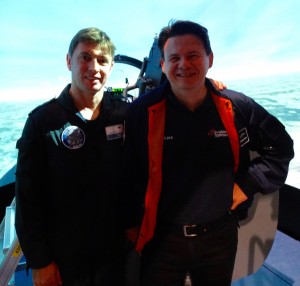2015-10-12 By Robbin Laird
During my visit to Europe in the early Fall of 2015, one of the subjects of interest was the cross cutting modernization of the Eurofighter with the introduction of the F-35.
Clearly, the Royal Air Force and the Italian Air Force are key players in this process, but I was also able to visit Munich to talk with some key Eurofighter personnel as well.

One of those personnel was Raffaele Beltrame who is the Eurofighter Project Test Pilot for Airbus Defence and Space, Germany.
Previously, he was a Tornado pilot in the Italian Air Force and clearly understands a key element of the Eurofighter transition, namely, the subsuming of Tornado missions within the Eurofighter for the RAF and the IAF.
He has been involved with Eurofighter since the introduction of the plane to the Italian Air Force in 2004.
He highlighted that with the Tornado they could load 2 Paveway GBUs but with Eurofighter they can load 6, and clearly from this standpoint, the aircraft represents an upgrade.
We discussed the upgrade process and the evolution of the Eurofighter as well as Beltrame providing demonstration of developments in the cockpit simulator which is tied in with the situation room at the Eurofighter facility in Munich, where scenarios are worked through for the pilot to work through.
Beltrame provided a number of key takeaways from our discussion.
First, the inclusion of the air to ground mission sets in the Eurofighter are progressing well.
This was not part of the original 1990s design but modifications of the Eurofighter are allowing for this evolution.
The program has implemented a number of aerodynamic improvements to the aircraft which allow for a better execution of both the air to air and air to ground mission sets.
Second, given the ability to hold six air to air missiles along with the air to ground missiles, the pilot can be focused on the air to ground but have available systems to protect himself in the air against intruders.
Third, the organic capabilities of the aircraft are expanding, and with the expansion of capabilities, the effort is to improve the capability of the pilot to manage those expanded tasks.
This is being done by enhanced automation, the use of voice commands, and an improved helmet and pilot interface to manage the information more effectively for the targeting task.
Fourth, the Eurofighter is designed to work in a network.
The further evolution of the Eurofighter is focused on improving its ability to work in a network,, notably one being reshaped by the introduction of the F-35.
For Beltrame, a major change in air combat was underway, whereby the classical C2 structure makes no sense with the coming of the F-35 and the expanded capability of the Eurofighter to execute tasks.
As he put it: “A hierarchy certainly remains; but he who has the best situational awareness should be directing the execution of the missions.”
He also saw a clear trend to enhance the ability of the ability to leverage automated systems to can better domain knowledge to make better decisions, and this was clearly part of the evolving air combat capabilities of 21st century forces, which in turn drove demand for a different kind of C2 system as well.
He focuses as well on the challenge for air power leaders to command a fleet of F-35s and Eurofighters, which would be capable of mixed mission operations over the spectrum of warfare.
The shift from limited and sequential targeting to dynamic targeting of an interactive fleet would be a major challenge moving forward.
In other words, shaping an effective C2 system for a dynamic fleet operating in a fluid battlespace has little in common with the slow motion war which we have experienced over the past 20 years.
The photos of the Italian operation in the Baltic Air Policing mission have been provided by the Italian Air Force.


